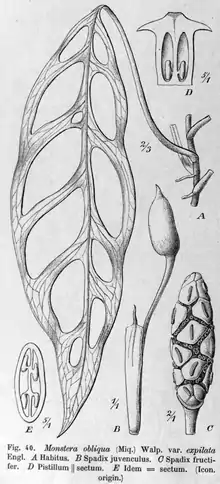Monstera obliqua
Monstera obliqua is a species of the genus Monstera native to Central and South America.[1] The most well known form of obliqua is the one from Peru, often described as being "more holes than leaf" but there are forms in the obliqua complex with little to no fenestration such as the Bolivian type. An illustration of the general variation in adult leaf shape from different individuals of this species can be found in Michael Madison's 'A Revision of Monstera'.[2] An hemiepiphytic climber like most other Monstera species, obliqua is particularly known for its foliage, which is often highly fenestrated, to the point where there is more empty space than leaf.[3] Quite expensive in cultivation, this species is often confused for other Monstera like Monstera adansonii.[4]
| Monstera obliqua | |
|---|---|
 | |
| Botanical illustration of M. obliqua by Adolf Engler | |
| Scientific classification | |
| Kingdom: | Plantae |
| Clade: | Tracheophytes |
| Clade: | Angiosperms |
| Clade: | Monocots |
| Order: | Alismatales |
| Family: | Araceae |
| Genus: | Monstera |
| Species: | M. obliqua |
| Binomial name | |
| Monstera obliqua Miq., Linnaea 18: 79 (1845) | |
References
- "Monstera obliqua Miq., Linnaea 18: 79 (1845).", World Checklist of Selected Plant Families
- Madison, Michael (1977). "A Revision of Monstera (Araceae)". Contributions from the Gray Herbarium of Harvard University (207): 3–100. ISSN 0195-6094. JSTOR 41764722.
- Deni Bown (2000), Aroids: Plants of the Arum Family, Timber Press, pp. 199, 201, 327, ISBN 978-0-88192-485-5
- "Monstera obliqua vs Monstera adansonii". Archived from the original on 7 February 2019. Retrieved 14 October 2019.